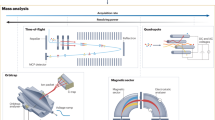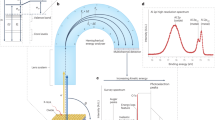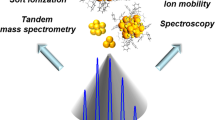Abstract
ALTHOUGH considerable effort in electron spectroscopy for chemical analysis (ESCA) has been channelled into the development of narrow line sources1–4, there has been little attention to the problem of increasing ESCA resolution by decreasing the large linewidth contribution from involatile non-conducting solid samples. For such samples, most workers have spread a thin layer of solid on to sticky tape5,6, or have used a metal mesh as host matrix7–9. Al has also been suggested as a sample backing by P. E. Larsen. These procedures generally provide widths approximately 1 eV broader than those from the gas phase1, thin condensed phase10, or from conductor1 spectra. The procedures normally involve the use of a few mg of compound, even though ESCA should be sensitive to ∼ 10−8 g of a material2,11.
This is a preview of subscription content, access via your institution
Access options
Subscribe to this journal
Receive 51 print issues and online access
$199.00 per year
only $3.90 per issue
Buy this article
- Purchase on Springer Link
- Instant access to full article PDF
Prices may be subject to local taxes which are calculated during checkout
Similar content being viewed by others
References
Gelius, U., Basilier, E., Svensson, S., Bergmark, T., and Siegbahn, K., J. Elect. Spectroscopy, 2, 405 (1973).
Siegbahn, K., et al., ESCA Applied to Free Molecules (North Holland Publishing, Amsterdam, 1969).
Siegbahn, K., et al., ESCA Atomic, Molecular and Solid State Structure Studied by Means of Electron Spectroscopy (Almqvist and Wiksells, Uppsala, 1967).
Electron Spectroscopy, edit. by Shirley, D. A. (North Holland Publishing, Amsterdam, 1972).
Tolman, C. A., Riggs, W. M., Linn, W. J., King, C. M., and Wendt, R. C., Inorg. Chem., 12, 2770 (1973).
Briggs, D., Clark, D. T., Keable, H. R., and Kilner, M., J. chem. Soc., Dalton Trans., 2143 (1973).
Betteridge, D., Carver, J. C., and Hercules, D. M., J. Elect. Spectroscopy, 2, 327 (1973).
Citrin, P. H., J. Am. chem. Soc., 95, 6472 (1973).
Dickinson, T., Povey, A. F., and Sherwood, P. M. A., J. Elect. Spectroscopy, 2, 441 (1973).
Clark, D. T., Chem. Commun., 230 (1971).
Hercules, D. M., Cox, L. E., Onisick, S., Nichols, G. D., and Carver, J. C., Analyt. Chem., 45, 1973 (1973).
Hnatowich, D. J., Hudis, J., Perlman, M. L., and Ragaini, R. C., J. appl. Phys., 42, 4883 (1971).
Thomas, J. M., Evans, E. L., Barber, M., and Swift, P., Trans. Faraday Soc., 67, 1875 (1971).
Conner, J. A., Hall, M. B., Hillier, I. H., Meredith, W. N. E., Barber, M., and Herd, Q., J. chem. Soc., Faraday II, 1677 (1973).
Author information
Authors and Affiliations
Rights and permissions
About this article
Cite this article
ADAMS, I., BANCROFT, G. Solution evaporation method for solid state ESCA studies. Nature 250, 219–220 (1974). https://doi.org/10.1038/250219a0
Received:
Revised:
Issue Date:
DOI: https://doi.org/10.1038/250219a0
This article is cited by
-
Organic superstructure microwires with hierarchical spatial organisation
Nature Communications (2021)
Comments
By submitting a comment you agree to abide by our Terms and Community Guidelines. If you find something abusive or that does not comply with our terms or guidelines please flag it as inappropriate.



